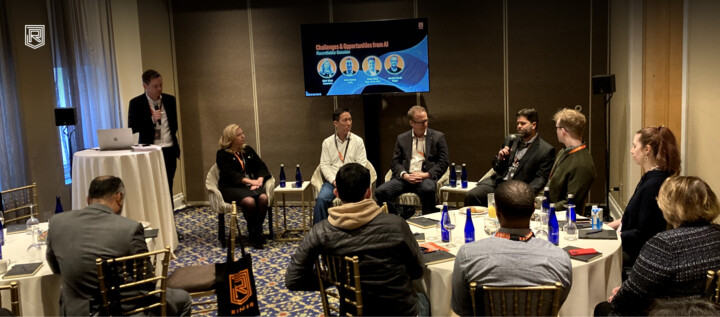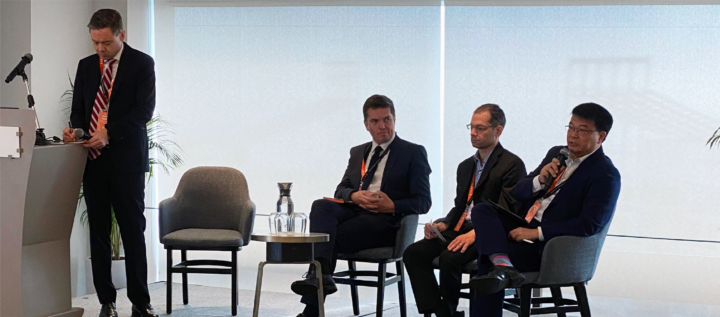The Ripjar Summit 2023 took place on 25 April 2023 at The Shard in London. The exclusive event saw senior compliance and fintech professionals from some of the world’s most prestigious banks and financial institutions participate in a discussion of the industry’s most pressing regulatory challenges, with a focus on the ways in which technological innovation delivers advantages in an evolving risk landscape.
Hosted by Ripjar’s Chief Product Officer Gabriel Hopkins, the expert panel included FINTRAIL Managing Director Maya Braine, Kharon Vice President of Sales Chris McDonagh, and Ripjar’s General Manager of Labyrinth Screening Simon McClive. The panel discussion was followed by a presentation from Ripjar’s Head of Analytics Simon Smith, on the application of AI Risk Profiles as part of an adverse media screening solution.
Let’s explore some of the highlights of the 2023 panel discussion.
What changes are we seeing in regulatory frameworks around screening?
In the context of screening challenges, the panellists pointed out that global regulators are converging around consistent messaging about the integration of technology and automation, including the sharing of AML/CFT data.
While the direction to use technology is sometimes featured in regulatory detail, the panel suggested that it was more often included in guidance and messaging from regulators, such as “Dear CEO” letters, and from enforcement actions, all of which offer clear signals about screening expectations. Panellists referenced a number of recent regulator publications that emphasised the importance of new AML technologies, including papers from the Financial Action Task Force (FATF), and the Wolfsberg Group. They also highlighted adverse media screening as an AML/CFT technology requirement in a growing number of jurisdictions – including the EU, the UK, Singapore and Australia.
How should organisations balance the use of adverse media in their screening process?
One panellist stressed the need to minimise false positives during the adverse media screening process, and avoid overwhelming compliance teams with information. With that in mind, it was suggested that adverse media screening could be made more efficient in conjunction with digital onboarding processes, which allow AML/CFT solutions to digest and distribute data quickly across a network, and to fine tune algorithms to increase the accuracy of their results.
Another panellist talked about the need to work with clients to develop the quality of the datasets they collect from adverse media screening. The better the quality of data, the more valuable it is for compliance teams, and the less likely it is to generate false positives. Essentially, firms should think less about volume and more about getting “good data, good technology, and then demonstrating a return on investment”.
Are we seeing innovation in specific regulatory areas?
One member of the panel raised adverse media screening as a particular focus for AML/CFT innovation. As banks trend away from high risk customers and towards services for retail customers, the panellist pointed out that adverse media screening becomes more challenging since it necessarily involves a higher volume of names and greater use of common names – both factors that typically generate resource-sapping false positive alerts. With that in mind, many institutions are seeking ways to leverage technology to meet their increased administrative burden and maximise compliance efficiency.
What kind of sanctions challenges can we expect in the future?
On the invasion of Ukraine, one member of the panel noted that a number of firms were caught off-guard by the speed with which the Russia sanctions landscape changed throughout 2022, and felt “blind” as a result of a lack of data. They spoke about the need to not only collect data but to understand it – so that it can be turned into actionable financial intelligence. Part of the challenge is to conduct effective horizon scanning, and for firms to think about their risk exposure in the event of certain geopolitical events. The panellist cited the tension between China and Taiwan as an area of increasing concern, and suggested that firms should use data from the implementation of current Russia sanctions programmes to anticipate potential pain points should new sanctions emerge.
Echoing those sentiments, another panel member noted that horizon scanning often poses a greater challenge for smaller organisations that may be forced to engage in a level of “geopolitical analysis” that they never anticipated. They suggested that external sanctions support, such as screening technology, can be a huge advantage for smaller firms in this context – as long as they are able to source sufficient risk data on their customers.
A third panellist referenced the need for timely data as a sanctions priority, especially in the fast-moving Russia-Ukraine space, pointing out that “UK sanctions grew from 150 people and 50 organisations, to around 1,500 people being sanctioned within 12 months”. In such a crowded landscape, firms must be able to make rapid decisions, taking into account language and transcription discrepancies, supply chain risks, and the possibility of future sanctions changes.
Following a series of massive sanctions fines in 2022, what are the lessons that banks should learn?
On the topic of AML/CFT failures, and subsequent investigations and enforcement actions, one panel member noted that “most of the time… banks are failing at the basics”. They cited failures of banks to perform rigorous KYC checks, internal compliance tests, audits, and quality assurance, as examples of some of the compliance fundamentals that institutions struggle with – and eventually result in violations and costly penalties. It was stated that it’s better to tackle these foundational problems from the ground up “as opposed to playing whack-a-mole, just dealing with the last thing flagged by a regulator”.
The importance of getting the compliance balance right was emphasised: “Greater use of data and tech is what’s going to solve this. You can’t keep throwing people at the problem. Ultimately, it’s going to be technology, automation, and using your data in a more intelligent manner.”
Another panellist also called on financial institutions to integrate technology to meet their basic compliance requirements, and to ensure they have adequate data to generate valuable positive outcomes. In this sense, it was stated that compliance should not be viewed as a “cost” but as a means of “actively protecting the business”.
Do generative AI tools such as ChatGPT have an important role to play in compliance?
Acknowledging the dramatic growth of generative language AI platforms over 2022 and 2023, the panel pointed out that the technology has strengths and weaknesses. While generative platforms are “very, very good” at summarising large volumes of information, and providing plausible responses to prompts, they are not always accurate or even factual. In screening contexts where there is an absence of facts, for example, it was suggested that generative AIs sometimes make incorrect assumptions – a trend that inevitably leads to false positive alerts. One panellist also pointed out that training AI models is a long and expensive process, often costing millions of dollars. The training process must include foreign languages, and must be constantly updated to account for new trends and risks.
Despite those drawbacks, it was emphasised that generative AI has clear, game-changing potential – for helping compliance teams digest huge volumes of data and to “identify risk in a way that isn’t just keyword driven”.
Another panellist pointed out that AI tools have “proven very useful” in compliance contexts for decades. In particular, they cited AI tools’ effectiveness in combating fraud, and running credit risk assessments and claims management processes. It was suggested that the significant challenge of generative AI is “explainability”: since users “do not know why it is saying what it is”, it cannot be tested, its results cannot be checked for accuracy, and it can’t be explained to regulators. That issue currently precludes generative AI from being used widely in screening contexts.
AI Risk Profiles in Adverse Media Screening
Following the Ripjar Summit’s panel discussion, Ripjar’s Simon Smith gave a presentation on the advantages of using AI technology to enhance adverse media searches.
Understanding AI Risk Profiles
In a crowded adverse media landscape, Simon Smith emphasised the need to reduce noise, especially in situations where “thousands, or potentially millions” of articles cover a single story. Simon suggested that firms need to be able to “pivot that article view of the world” into an “entity focus” and noted that Ripjar is achieving that objective by launching technology capable of creating “risk profiles” of individual customers.
He explained how Ripjar’s AI Risk Profiles pull together the most relevant data from different financial risk topics, including sanctions list and watchlist data, to map out an entity’s risk exposure much more efficiently than searches of thousands of adverse media stories.
Creating a Risk Profile
Simon demonstrated the AI Risk Profile technology with a profile for Belarussian president Alexander Lukashenko. In creating the profile, the system identified relevant information, from news articles and other media, that linked to specific risks, including sanctions risks and financial risks, in order to build out a comprehensive, accurate risk profile. The profile integrated Lukashenko’s relatives and close associates, and set out the reasons why he was considered to be high risk, including connections to money laundering and voter fraud activities.
The Advantages of AI Risk Profiles
Ripjar’s AI Risk Profile technology essentially allows firms to take huge volumes of data and then automatically resolve that data around a single profile in order to “make it easy to surface the risks”. Simon referenced firms using article-based adverse media screening and generating unmanageable volumes of results from their searches, reaching into the tens of thousands, but then only finding a relatively low number of genuine risks. By contrast, AI Risk Profile technology significantly reduces the false positive alert rate, by up to 99% in some cases, while increasing the number of accurately identified risks.
Simon used the example of a criminal with the name “David Hugh Cameron” – a close name match to the previous UK prime minister. Article-based searches for the target name were swamped with results relating to the former prime minister, but with Ripjar’s AI Risk Profiles, firms are able to explore a list of the relevant individuals, with specific risk data integrated into each profile. Simon characterised the new approach as a “holistic view” of risk that captured a range of meaningful negative news signals about an individual in order to deliver a truer profile.
Discover Labyrinth Screening
What was clear from the Ripjar Summit is that the global risk landscape is changing, and organisations need to be prepared to meet their compliance challenges as soon as they emerge. With that goal in mind, Ripjar’s Labyrinth Screening platform is capable of searching thousands of global data sources including watchlists, sanctions lists and news stories, in over 20 foreign languages, and delivering quality, actionable intelligence in seconds. Powered by cutting edge machine learning technology, Labyrinth enables you to extract the most relevant AML data, in order to minimise noise and false positives, and build more accurate, meaningful risk profiles for every customer.
To learn more about how Ripjar can help you manage compliance challenges, get in touch today
Last updated: 31 January 2025





